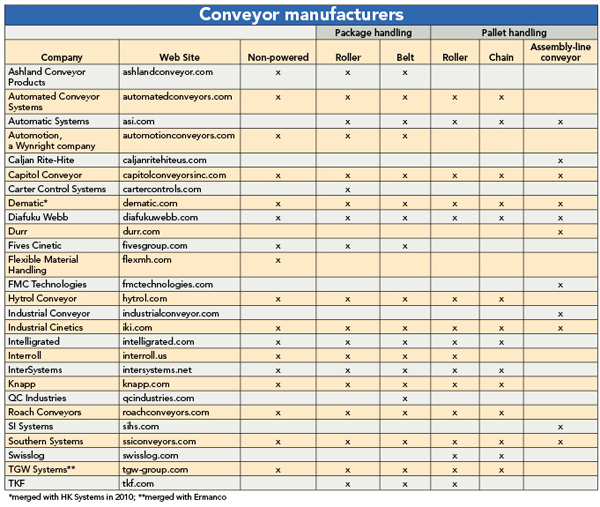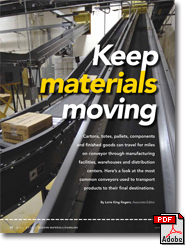Equipment 101: Conveyors
Cartons, totes, pallets, components and finished goods can travel for miles on conveyor through manufacturing facilities, warehouses and distribution centers. Here’s a look at the most common conveyors used to transport products to their final destinations.
Latest Material Handling News
Radial stays ahead of the automation curve Wireless Mobility: Ready for the next leg up AGVs set new standards for inventory transportation Inside North Shore Care Supply: Bringing robots to receiving Bergen Logistics: Putting robots to work in a multi-tenant facility More Equipment ReportConveyor has been a staple in the materials handling industry for decades. As the demand for reduced cost, increased throughput and integrated automation grows, so does the need for conveyor systems of all types.
Conveyor is available in many styles and is used in countless applications. In this Equipment 101 article, Modern spotlights the basics of some of the most common conveyor types:
- Non-powered skatewheel and roller conveyor
- Powered, or live, belt and roller conveyor used in handling packages and other small products
- Powered chain and roller conveyor used in handling pallet loads of goods
Non-powered Conveyor
Portable sections of non-powered conveyor are often used for loading packages onto the back of an over-the-road truck. Non-powered conveyor can also serve as takeaway conveyor for cartons coming out of an automated sorter, and it’s often used in workstations and pick modules where employees complete their tasks and then push their work along to the next zone or station. The two most common types of non-powered conveyor are skatewheel and roller.
Skatewheel conveyor
Only a little energy is needed to turn the small wheels of a skatewheel conveyor, and that makes skatewheel good at maintaining the speed of a product. Because each wheel turns independently, skatewheel conveyor is also a good choice for the curved sections of a conveyor line.
Roller conveyor
Non-powered roller conveyor is commonly used for workstations and pick modules because it provides a better working surface and is often less expensive than skatewheel conveyor. It’s also good at slowing the inertia of products coming out of a high-speed sorter.
Whether it’s skatewheel or roller, non-powered conveyor that relies on gravity to move product is still used a lot in the market, says Russ Devilbiss, sales manager for Carter Controls and chair of the Material Handling Industry of America’s (MHIA) Conveyor & Sortation Systems industry group. The limitation with non-powered conveyor, however, is control. “With gravity, you can’t control the force, and you always want to be in control of your product,” says Devilbiss.
Powered Package-handling Convveyor
When it comes to moving packages and other relatively small items, two styles of conveyor dominate the market: belt conveyor and powered roller conveyor.
Traditionally, belt conveyor has been used for transporting products, while roller conveyor has been used for accumulating products.
Another factor taken into consideration when choosing between belt or roller conveyor depends on the size of the product being moved.
Belt conveyor
In traditional belt conveyor, an AC motor drives a pulley that then turns a long, looped belt. Underneath the belt sits either a bed of non-powered rollers or a sheet of metal known as a slider bed. The belt can be made of a variety of materials with a variety of surfaces, depending on the items it is intended to convey.
For example, according to Ken Ruehrdanz, warehousing and distribution market manager for Dematic, a belt surface can be smooth where you need to slide an item off a conveyor easily or ribbed to give it more gripping power, like on inclines and declines.
And, belted incline or decline conveyor can be used to move product from one level of a facility to another. Spiral conveyor is another way to move product from one level to another. If floor space is limited, spiral conveyors are often a good solution.
Regardless, traditional belt conveyor is a simple, time-tested technology. It’s less expensive than powered roller conveyor, it provides a more stable surface, and it can convey a variety of products. Poly bags, envelopes and electronics are examples of products handled easily by belt conveyor that are often too small or too light to be conveyed directly on rollers.

Roller conveyor
Despite the advantages of belt conveyor, many of today’s distribution centers are filled with roller conveyor because it allows accumulation of products. Accumulation is a way to make the conveyor store product for a determined amount of time then released into an automated sorter or palletizer, for example.
Zero pressure accumulation means products on the conveyor do not touch each other. Minimum pressure accumulation, however, allows the products to make contact, but with a determined degree of impact that will not cause damage.
Powered roller conveyor falls into a number of different categories, depending on the way the rollers are driven. Three common categories are line-shaft, belt-driven and motorized roller.
Line-shaft conveyor: In a section of line-shaft conveyor, a long metal shaft runs below the bed of rollers. Rubber o-rings connect the rollers to the shaft so that when the motor turns the shaft, the shaft turns the rollers.
Line-shaft conveyor is the least expensive type of roller conveyor. It has been in the market for a long time, but it has limitations. Even though line-shaft conveyor costs less, explains Don Erickson, director engineering for Automotion, it is parts-intensive, which leads to high maintenance requirements.
Belt-driven roller: Belt-driven roller conveyor is driven by a belt (usually covered with a rubber or plastic pad) that runs beneath the roller bed, perpendicular to the rollers. As a motor moves the belt, the belt moves the rollers. Belt-driven roller is a good accumulator because it’s easy to create zones. You can drop the belt away from the roller in any zone where you want to create accumulation.
Motorized roller: Motorized roller is also known as internal motor or motor-driven roller (MDR) conveyor. A section of motorized roller conveyor is divided into small zones. At least one roller in each zone has an internal motor that turns the roller. The rollers in each zone are connected to each other by rubber o-rings so that the turning of the motorized roller turns all the rollers in the zone.
The motors used in motorized roller are usually 24-volt DC motors. These motors use less energy than the motors used to drive other forms of roller conveyor and they provide less torque, making them safer, too.
Because each zone of rollers is powered independently, the zones can be configured to run only when a package is present. This on-demand feature increases energy savings even further and decreases noise—both are important factors when the end user is addressing economics and ergonomics.
Motorized roller doesn’t move as fast as the other forms of roller conveyor, because it’s a smaller, low-voltage DC configuration is designed to power only one zone, but it offers better product control and is easier to maintain.
The upfront cost of motorized roller is higher than other forms, but as usage goes up, price of the components is coming down.
With any roller conveyor, there’s a basic rule of thumb: “You want three rollers under your product at all times,” explains Devilbiss. Two rollers might create a wobble when the product hits a gap, but keeping the front, middle and back of a product supported will provide a smooth ride.”
Segmented belt conveyor
The invention of motorized roller conveyor has led to the development of segmented belt conveyor. A section of segmented belt conveyor is essentially a section of motorized roller conveyor with a few feet of belting wrapped around each zone of rollers.
Segmented belt conveyor combines the accumulating power of roller conveyor with the stability of belt conveyor, resulting in excellent carton control.
Controlled flow conveyor
Another newer kind of conveyor is known as controlled flow conveyor. A hybrid between non-powered gravity conveyor and MDR, controlled flow conveyor skews product to one side then singulates it out on the decline at a controlled rate.
“Additional advances are still finding their way into different aspects of MDR systems,” says Kevin Kleuber, product manager at Intelligrated. “With a controlled flow conveyor system, the declining conveyor uses gravity which allows for product accumulation at a lower cost than traditional belt conveyor.”
Powered Pallet-handling Conveyor
Pallet-handling conveyor is often used in conjunction with automatic palletizers or automated storage and retrieval systems (AS/RS). There are two basic types of pallet-handling conveyor: chain conveyor and roller conveyor. Both can handle heavy loads up to 4,000 pounds and both are relatively slow, typically handling just four pallet loads per minute.
Pallet-handling chain conveyor
Chain conveyor is a simple technology that uses motors to turn two, three or four strands of heavy-duty chain. The pallets ride directly on the chain. Chain conveyor is less expensive than roller conveyor, and it’s best suited for captive systems where pallets are a uniform size and in good condition.
Pallet-handling roller conveyor
Pallet-handling roller conveyor looks like the roller conveyor used for handling packages, but the rollers are wider and thicker. Most pallet-handling roller conveyor is chain-driven because the drive method is the toughest and hardiest.
Chain-driven pallet conveyor works differently from chain-driven package conveyor. Instead of running beneath the rollers, the chain runs along one side of the roller bed. Each roller is connected to the chain with a sprocket. The conveyor is divided into small segments, and each segment has its own AC induction motor. This segmentation allows for better control and allows some accumulation of pallets.
The use of internal DC motors to drive pallet-handling rollers is available, but growing slowly mainly because the advantages don’t justify the cost. “MDR is expensive,” explains Kleuber. “With pallet conveyor, the MDR advantages aren’t worth extra money. Traditional conveyor can get the job done at a lower cost.”
Conveyor flexibility
Containing costs throughout a facility is a real and constant challenge. Thanks in part to the modularity of the components and the ease of integration, today’s conveyor systems can have a long life cycle, which translates into savings.
In any manufacturing facility, warehouse or distribution center, flexibility and scalability are the name of the game, says Clint Lasher, president of Wynright Engineers & Integrators Division. “Materials handling equipment, including conveyor systems, have to adapt quickly to an end user’s needs. Customers want systems to grow with them at their rate, so it’s up to suppliers to design and apply modular products that are easy to integrate and that can scale a system up to handle increased flow or additional box sizes when necessary.”

Article Topics
Equipment Report News & Resources
Radial stays ahead of the automation curve Wireless Mobility: Ready for the next leg up AGVs set new standards for inventory transportation Inside North Shore Care Supply: Bringing robots to receiving Bergen Logistics: Putting robots to work in a multi-tenant facility High-tech meets low-tech: Automate storage for pallet loads Tuggers, carts work together to increase productivity and ergonomics More Equipment ReportLatest in Materials Handling
Registration open for Pack Expo International 2024 Walmart chooses Swisslog AS/RS and software for third milk processing facility NetLogistik partners with Vuzix subsidiary Moviynt to offer mobility solutions for warehouses Materials Handling Robotics: The new world of heterogeneous robotic integration BSLBATT is looking for new distributors and resellers worldwide Lucas Watson appointed CSO for Körber’s Parcel Logistics business in North America Hyster recognizes Dealers of Distinction for 2023 More Materials HandlingAbout the Author
Subscribe to Materials Handling Magazine

Find out what the world's most innovative companies are doing to improve productivity in their plants and distribution centers.
Start your FREE subscription today.
April 2024 Modern Materials Handling

Latest Resources











